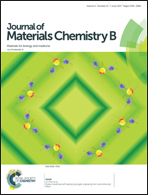NIR absorbing Au nanoparticle decorated layered double hydroxide nanohybrids for photothermal therapy and fluorescence imaging of cancer cells†
Abstract
Among inorganic nanomaterials, layered double hydroxides (LDHs) and gold nanoparticles (Au NPs) have received great attention in nanobiomedicine due to their unique properties. In this work, we have designed a nanohybrid of an LDH with Au NPs (LDH–Au) in order to use it for photothermal therapy, and optical and fluorescence imaging of cancer cells. The structural characteristics of the nanohybrid are investigated using X-ray diffraction, infrared spectroscopy, electron microscopy and elemental analyses. The extinction spectra of the nanohybrid exhibits broad absorption ranging from the visible to near infrared (NIR) region (500–1000 nm). The photothermal activity of the nanohybrid is explored using NIR laser irradiation. The electric field enhancement in the nanohybrid due to the interaction of Au NPs on the LDH is speculated through finite-difference time-domain (FDTD) calculations. The LDH–Au nanohybrid is found to be biocompatible with normal murine fibroblast (L929), human breast cancer (MCF-7) and cervical cancer (HeLa) cell lines up to a concentration of 1 mg mL−1. The nanohybrid is explored for in vitro photothermal therapy of MCF-7 and HeLa cell lines. As a photothermal agent, the nanohybrid shows that 10 min exposure to an 808 nm laser (500 mW) is adequate to inhibit about 70% of cancer cells. Further, the nanohybrid is tagged with FITC to study both optical and fluorescence imaging with MCF-7 cell lines. The results demonstrate that the LDH–Au nanohybrid provides an innovative approach to photothermal therapy, and optical and fluorescence imaging of cancer cells.



 Please wait while we load your content...
Please wait while we load your content...